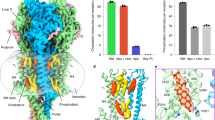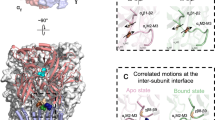Abstract
THE physiological chemotransmitter acetylcholine and its structural analogues such as carbamylcholine are capable of producing a sustained blockade of neuromuscular transmission when applied to the neuromuscular junction for prolonged periods. This neuromuscular blockade is not due to a depolarisation of the postsynaptic muscle fibre membrane but rather is generally ascribed to the inactivation, or ‘desensitisation’ of cholinergic receptor molecules in the postsynaptic membrane1,2. Various kinetic models involving agonist, and receptor molecules postulated to exist in different conformational states, have been proposed to account for the time course of the desensitisation process2,3. These models do not incorporate the acceleration of desensitisation by calcium ions4,5 and they do not predict correctly the observed effects of certain cholinergic antagonists on desensitisation. Consequently, alternative models for desensitisation have been proposed. In one of them calcium ions accumulate at the interior surface of the post-synaptic membrane and bind to the cholinergic receptors, thereby causing desensitisation by producing or sustaining some inactive receptor conformation6. We tested the model for desensitisation which involves internal calcium binding. This was accomplished by facilitating calcium ion flux across the post-synaptic membrane using the divalent cation ionophore A23187, while simultaneously producing a rapid desensitisation with iontophoretic application of carbamylcholine. Our results provide further evidence that calcium ions are a significant factor in the molecular mechanism of desensitisation.
This is a preview of subscription content, access via your institution
Access options
Subscribe to this journal
Receive 51 print issues and online access
$199.00 per year
only $3.90 per issue
Buy this article
- Purchase on Springer Link
- Instant access to full article PDF
Prices may be subject to local taxes which are calculated during checkout
Similar content being viewed by others
References
Thesleff, S. Acta physiol. scand. 34, 218–231 (1955).
Katz, B. & Thesleff, S. J. Physiol., Lond. 138, 63–80 (1957).
Rang, H. P. & Ritter, J. M. Molec. Pharmac. 6, 357–382 (1970).
Manthey, A. A. J. gen. Physiol. 49, 963–975 (1966).
Magazanik, L. G. & Vyskocil, F. J. Physiol., Lond. 210, 507–518 (1970).
Nastuk, W. L. & Parsons, R. L. J. gen. Physiol. 56, 218–249 (1970).
Reed, P. W. & Lardy, H. A. in The Role of Membranes in Metabolic Regulation (eds Mehlman, M. A. & Hanson, R. W.) 111–131 (Academic Press, New York, 1972).
McLaughlin, S. & Eisenberg, M. A. Rev. Biophys. Bioengng 4, 335–366 (1975).
Caswell, A. H. & Pressman, B. C. Biochem. biophys. Res. Commun. 49, 292–298 (1972).
Scarpa, A., Baldassare, J. & Inesi, G. J. gen. Physiol. 60, 735–749 (1972).
Hainut, K. & Desmedt, J. E. Nature 252, 407–408 (1974).
Inoue, F. & Frank, G. B. Br. J. Pharmac. Chemother. 30, 186–193 (1967).
Okada, K. Jap. J. Physiol. 17, 245–261 (1967).
Devore, D. I. & Nastuk, W. L. Nature 253, 644–646 (1975).
Miledi, R. Proc. R. Soc. B183, 421–425 (1973).
Huxley, A. F. J. Physiol., Lond. 243, 1–43 (1974).
Nastuk, W. L. Fedn Proc. 12, 102 (1953).
Wolfson, C. H. & Nastuk, W. L. Fedn Proc. 34, 404 (1975).
Hartzell, H. C., Kuffler, S. W. & Yoshikami, D. J. Physiol., Lond. 251, 427–463 (1975).
Wolfson, C. H. thesis, Columbia Univ. (in preparation).
Ebashi, S., Endo, M. & Ohtsuki, I. Q. Rev. Biophys. 2, 351–384 (1969).
Martinez-Carrion, M. & Raftery, M. A. Biochem. biophys. Res. Commun. 55, 1156–1164 (1973).
Cohen, J. B., Weber, M. & Changeux, J-P. Molec. Pharmac. 10, 904–932 (1974).
Chang, H. W. & Neumann, E. Proc. natn. Acad. Sci. U.S.A., 73, 3364–3368. (1976).
Author information
Authors and Affiliations
Rights and permissions
About this article
Cite this article
DEVORE, D., NASTUK, W. Ionophore-mediated calcium influx effects on the post-synaptic muscle fibre membrane. Nature 270, 441–443 (1977). https://doi.org/10.1038/270441a0
Received:
Accepted:
Issue Date:
DOI: https://doi.org/10.1038/270441a0
This article is cited by
-
Calcium influxes and calmodulin modulate the expression and physicochemical properties of acetylcholinesterase molecular forms during developmentin vivo
Cellular and Molecular Neurobiology (1993)
-
Desensitization of the nicotinic acetylcholine receptor: Molecular mechanisms and effect of modulators
Cellular and Molecular Neurobiology (1989)
Comments
By submitting a comment you agree to abide by our Terms and Community Guidelines. If you find something abusive or that does not comply with our terms or guidelines please flag it as inappropriate.



